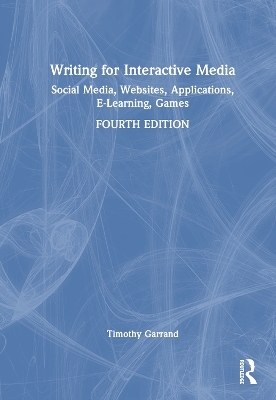
Writing for Interactive Media
Routledge (Verlag)
978-1-032-55425-9 (ISBN)
This comprehensive guide is grounded in the core principles and skills of interactive media writing, in which writers create text and structure content to guide users through interactive products such as websites or software. The book examines case studies on interactive formats including complex informational websites, computer games, e-learning courses, training programs, and immersive exhibits. These case studies assess real-world products and documentation used by professional writers such as scripts, outlines, screenshots, and flowcharts. The book also provides practical advice on how to use interactive media writing skills to advance careers in the social media, technical, instructional communication, and creative media fields. This edition includes new chapters on UX Writing and Content Design, Social Media Writing, and Writing for Mobile.
Writing for Interactive Media prepares students for the writing challenges of today’s technology and media. It can be used as a core textbook for courses in UX Writing, Writing for Digital Media, and Technical and Professional Communication and is a valuable resource for writing professionals at all levels.
Supplemental resources include a sample syllabus, class assignments, student exercises, scripts, outlines, flowcharts, and other interactive writing samples. They are available online at www.routledge.com/9781032554242
Timothy Garrand is a Lead UX Product Designer who has led numerous projects for major corporations including JPMorgan Chase & Co., Merrill Lynch, Bloomberg, Proctor & Gamble, and Iron Mountain.
Part I: Challenges Writing for Interactive Media 1. The Challenge of Interactivity 2. Writing for Many Media 3. Interactive Writing Tools and Script Formats 4. Collaborating with a Team 5. Key Points from Part I: Challenges Writing for Interactive Media Part II: Conversational Writing—UX Writing, Social Media, Mobile 6. UX Writing and Content Design—Software and Applications 7. Social Media Writing—Twitter, Facebook, Instagram, TikTok 8. Writing for Mobile—Phones, Tablets, Readers 9. Key Points from Part II: UX Writing, Social Media, Mobile Part III: Writing and Structuring Long Form Interactive Information—Websites, E-Learning, Simulations 10. Defining and Achieving Goals for Interactive Information Projects 11. Information and Interactive Architecture Patterns 12 Writing a Marketing Website from Proposal to Documentation: Realty 13. Educational Simulation: The Nauticus Shipbuilding Company 14. E-Learning: Interactive Math and Statistics Lessons 15. Key Points from Part III: Websites, E-Learning, Simulations Part IV: Writing and Designing Interactive Narrative—Games, Immersive Experiences 16. Interactive Multimedia Narrative vs. Linear Narrative 17. The Elements of Interactive Narrative 18. Adapting a Classic Book to a Computer Game for the Female Audience: Nancy Drew: Secret of the Old Clock 19. Using Narrative to Present Information: The New England Economic Adventure 20. Adding Story to a Simulation Amped III 21. Key Points from Part IV: Writing and Designing Interactive Narrative Part V: Interactive Writing Careers 22. Conclusion and Career Tips
| Erscheinungsdatum | 24.10.2023 |
|---|---|
| Zusatzinfo | 20 Tables, black and white; 39 Line drawings, black and white; 22 Halftones, black and white; 61 Illustrations, black and white |
| Verlagsort | London |
| Sprache | englisch |
| Maße | 178 x 254 mm |
| Gewicht | 780 g |
| Themenwelt | Sozialwissenschaften ► Kommunikation / Medien ► Kommunikationswissenschaft |
| ISBN-10 | 1-032-55425-8 / 1032554258 |
| ISBN-13 | 978-1-032-55425-9 / 9781032554259 |
| Zustand | Neuware |
| Informationen gemäß Produktsicherheitsverordnung (GPSR) | |
| Haben Sie eine Frage zum Produkt? |
aus dem Bereich


